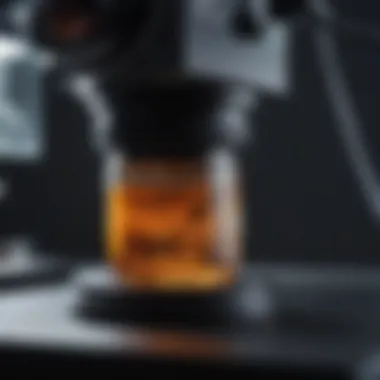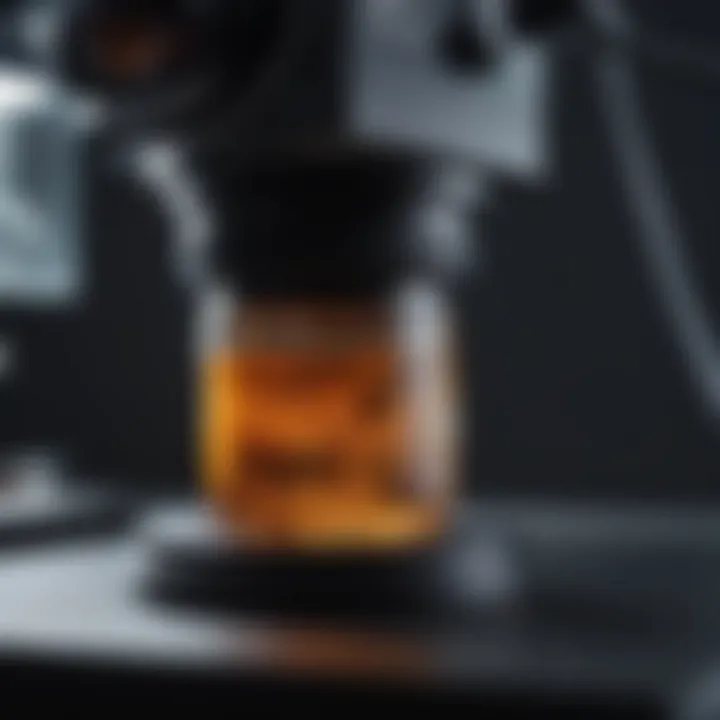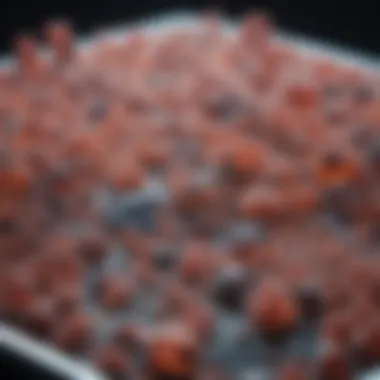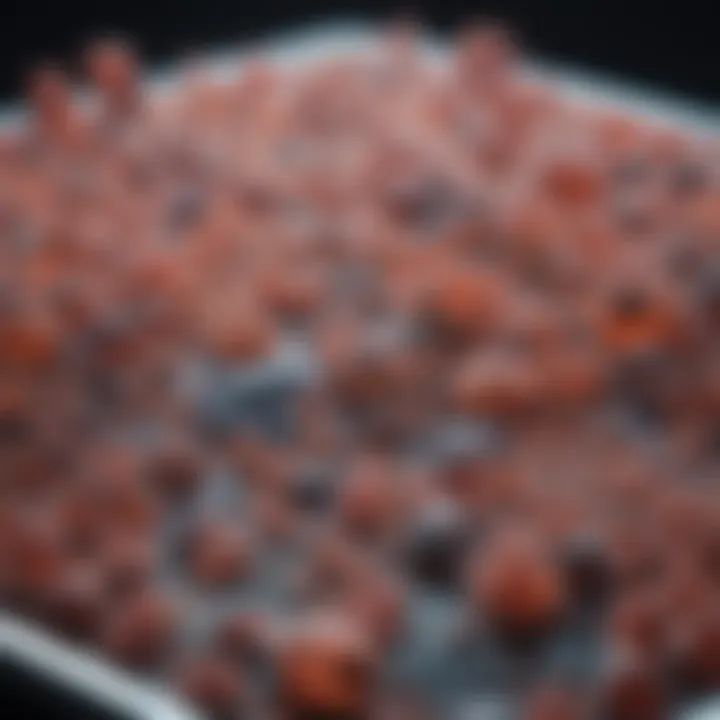Live Cell Microscopy: Techniques and Future Prospects


Intro
Live cell microscopy has revolutionized the way we observe and understand biological processes at the cellular level. By allowing researchers to study cells in their natural environment, this approach opens new avenues for investigating cellular dynamics and interactions over time. For anyone engrossed in the life sciences, grasping the intricacies of live cell microscopy is essential. This section aims to provide a clear roadmap into the techniques employed, the breadth of applications, and the potential advancements that could shape the future of this vital field.
Prologue to Live Cell Microscopy
In the realm of biological research, the ability to observe living cells in real-time has ushered in a new era of discovery. Live cell microscopy is not just a technique; it represents a paradigm shift in our understanding of cellular behavior and interactions. By enabling scientists to visualize cellular processes as they occur, it transforms static images into dynamic narratives filled with insights into the inner workings of life.
The importance of live cell microscopy extends beyond mere observation. Researchers can study phenomena such as cell division, migration, and responses to stimuli without the interference that often accompanies traditional methods. This immediacy allows for a more holistic view of cellular functions and forms the crux of various applications within fields like pharmacology, developmental biology, and stress responses.
Defining Live Cell Microscopy
To define live cell microscopy, it helps to understand that the term encompasses a variety of imaging techniques designed for the direct observation of living cells. Unlike standard microscopy methods where samples may be fixed and stained, live cell microscopy retains the dynamic characteristic of cells. In simplest terms, it is about watching cells in their natural state, as they engage in cellular processes.
This cellular observation can be achieved through a number of methods such as fluorescence microscopy, phase contrast, and more advanced techniques like super-resolution microscopy. These methods employ various forms of illumination and detection which allow for detailed imaging of not just the cell’s structure but also its behavior under different conditions.
One key aspect of live cell microscopy is that it requires careful preparation of samples and consideration of the environment in which these cells are maintained. Cellular integrity is vital; hence, factors like temperature, pH, and the presence of nutrients all play significant roles in successful live imaging.
Historical Overview
The journey of live cell microscopy is as fascinating as the cells it studies. Early microscopy birthed in the 17th century relied on simple light and lenses, providing only rudimentary views of biological samples. However, it wasn’t until the advent of fluorescence microscopy in the late 19th century that the potential for dynamic observation started to materialize. The creation of fluorescent dyes allowed researchers to tag cellular components and observe them under specific wavelengths of light.
Through the 20th century, rapid advancements continued. The introduction of confocal microscopy in the 1980s marked a pivotal moment, offering improved resolution and depth, enabling clearer imaging of thicker specimens. This ushered in an age where live cell microscopy could become an invaluable tool in real-time study conditions.
Now, with modern advancements in technology and the urgency of understanding cellular processes under live conditions, live cell microscopy has solidified its place in contemporary biological research. Today, it represents not just a technique, but a framework through which vast fields of science intersect and expand, exemplifying the merger of biology with physics and engineering.
Core Principles and Technologies
Understanding the core principles and technologies of live cell microscopy is critical for grasping its significance in modern biological research. This section aims to shed light on the basic mechanics of microscopy that facilitate the visualization of dynamic cellular processes. Live cell imaging is a powerful tool, as it allows researchers to observe cells in their natural environment, offering insights that static images or fixed cells cannot provide. The choice of technique not only affects the resolution of images but also impacts the biological state of the cells being studied. By comprehending the fundamental principles and various microscopy techniques, readers can appreciate how they contribute to the broader scope of cell biology and the potential applications in different research fields.
Fundamental Principles of Microscopy
At the heart of microscopy lies a few essential principles that govern how images of small objects are formed. Light, being the primary medium, interacts with different materials to produce varied visual effects. Light microscopy typically operates on the premise that light waves can be manipulated through lenses to magnify small organisms or cellular components.
Key principles include:
- Refraction: Bending of light as it passes through different media.
- Resolution: The ability to distinguish two close objects as separate entities. High resolution is vital for distinguishing finer details within the cell.
- Contrast: Differences in the opacity or luminosity of the cellular components can enhance visibility.
When these principles converge, they enable vivid visualization of cellular activities. For students and researchers, it’s essential to grasp these concepts to utilize microscopy effectively in their work.
Fluorescence Microscopy
Fluorescence microscopy is a powerful technique that enables visualization of specific cellular components through fluorescent markers. This method hinges on the principle of fluorescence, where certain molecules absorb light at one wavelength and re-emit it at another. It’s particularly effective for observing proteins, nucleic acids, and other biomolecules tagged with fluorescent dyes or proteins.
Some benefits include:
- High specificity: Allows targeting of specific proteins within a complex cellular milieu.
- Multicolor imaging: Multiple fluorescent tags can be used simultaneously, providing a wealth of information.
- Live imaging: Enables observation of dynamic processes in real-time, a crucial asset for studies like protein interactions and cellular responses.
Despite its merits, one must also be wary of potential issues, like photobleaching, where the fluorescent signal diminishes over time due to exposure to light.
Phase Contrast and Differential Interference Contrast Microscopy
These techniques revolutionized how we visualize live cells by increasing contrast without staining, thus preserving cellular integrity.
- Phase Contrast Microscopy enhances contrast in transparent specimens by converting phase shifts in light passing through different parts of the cell into brightness variations. This is particularly useful for observing living cells, as it reflects their multiple cellular components without altering their natural state.
- Differential Interference Contrast (DIC) takes this further by using two beams of light that create a pseudo-3D effect. This technique provides clearer and more detailed images of cellular structure, which is advantageous for examining subtle morphological changes during cell division or cellular movement.
Super-Resolution Microscopy
Super-resolution techniques push the boundaries of what can be visualized at the cellular level. Traditional light microscopy is limited by diffraction, but methods like STED (Stimulated Emission Depletion) and PALM (Photo-activated Localization Microscopy) can achieve resolutions down to tens of nanometers. This advancement allows researchers to visualize structures previously thought to be beyond reach, such as individual proteins and their interactions within the cellular context.
Advantages include:
- Enhanced resolution beyond the diffraction limit, critical for detailed cellular studies.
- Ability to observe and measure dynamic processes with unprecedented details.
The implications for drug discovery and developmental biology are profound as it lays the groundwork for understanding complex cellular functions.
Light Sheet Microscopy
Light sheet microscopy represents another leap forward in imaging technology. This method involves illuminating the sample with a thin sheet of light, allowing for rapid image acquisition at relatively low phototoxicity levels, which is a common concern with conventional methods.
- Key aspects:


- Low phototoxicity: Significantly reduces cellular damage, enabling longer observation periods.
- Fast imaging: Capable of capturing multiple planes of focus rapidly, making it suitable for observing developmental processes in living organisms.
- 3D imaging capabilities: Offers comprehensive views of sample volumes, providing insights into complex biological structures.
These advantages position light sheet microscopy as a robust tool for studying organisms at various developmental stages, offering pathways toward understanding tissues in their functional states.
In summary, these core principles and technologies underpin the advancements in live cell microscopy, making it an essential area of focus for researchers and students alike, as it profoundly impacts biological understanding and innovation.
Preparing Cells for Live Imaging
The significance of preparing cells for live imaging is like laying a strong foundation for a house; it determines how well the overall structure will hold up. Without proper preparation, insights gained from the imaging might be skewed or unreliable. In live cell microscopy, where the goal is to observe dynamic processes, the quality of the cells can directly impact the clarity and usefulness of the data obtained. This section will dive into the crucial techniques and considerations involved in preparing cells for comprehensive live imaging, ensuring that researchers can obtain accurate and meaningful observations.
Cell Culture Techniques
Cell culture serves as the cornerstone of live imaging experiments. The choice of cell types and their culture conditions can significantly influence experimental outcomes. Different cell types require distinct media, atmospheric conditions, and substrates. For instance, adherent cells like HeLa or COS-7 need surfaces coated with extracellular matrix proteins, whereas suspension cells require specialized flasks or dishes.
Here are some key factors that should be considered:
- Sterility: Ensuring that all procedures take place in sterile environments minimizes contamination risks, preserving the integrity of the cells.
- Nutrient Availability: The medium must be supplemented with the necessary nutrients and growth factors that maintain cell health and functionality.
- Passaging and Density: Regular sub-culturing is vital to avoid over-confluence; too-high density can lead to altered cellular behavior that complicates imaging.
Cell culture also involves specific techniques such as using controlled conditions (CO2 incubators) to maintain physiological temperatures and humidity, which are pivotal for sustaining cell viability during experiments. Visualization of cellular dynamics will be unreliable if the cells aren’t in peak condition.
Environmental Control during Imaging
The environmental setup during imaging can be a game changer in obtaining meaningful data. Maintaining appropriate temperature, pH, and gas concentrations is essential. Any fluctuations may cause cellular stress, leading to altered behaviors that don't reflect normal physiology.
Important considerations for environmental control include:
- Temperature: Generally, live cell imaging is performed at 37°C, closely mimicking in vivo conditions. Temperature control units or stage heaters help maintain this constant.
- CO2 Levels: Maintaining physiological levels of carbon dioxide during imaging can help regulate cellular pH, thus ensuring accurate cellular responses are captured.
- Humidity Control: Desiccation of cells can happen rapidly once they are exposed to the open environment of the microscopy stage. Employing humidified chambers can help in countering this effect.
Given the nature of the biological processes being studied, ensuring that conditions remain as close to natural as possible is paramount to avoid artifacts that can arise from improper environmental conditions.
Labeling Techniques for Cellular Components
Labeling techniques significantly enhance the visibility of specific cellular components, making them indispensable for live cell microscopy. Targeting particular proteins or organelles enables researchers to monitor dynamics clearly and quantitatively. However, these techniques come with their own set of challenges and considerations.
Fluorescent labeling is the most common approach.
- Selectivity: Using specific fluorescent probes that bind selectively to the molecules of interest ensures that only relevant parts of the cell are highlighted, thus reducing background noise.
- Non-toxic Reagents: It is essential to choose dyes or probes that do not interfere with cell health. Some probes can cause phototoxicity or alter cellular behavior if introduced in excess.
- Temporal Resolution: When labeling cells, it’s crucial to time the introduction of labels relative to the imaging session, as fluorescence may diminish over time (bleaching) or the cellular processes may change too rapidly to capture effectively.
Applications of Live Cell Microscopy
Live cell microscopy serves as a linchpin in understanding biological processes at the cellular level. Its applications stretch widely across numerous fields, allowing for the dissection of cellular dynamics, responses, and functions with a level of detail that was previously unattainable. The ability to visualize living cells in action not only enriches scientific knowledge but also propels innovations in healthcare, pharmacology, and developmental biology. As we delve into these applications, it becomes evident that the benefits and insights gleaned from live cell imaging intertwine seamlessly with the advancement of life sciences.
Cellular Dynamics and Behavior Studies
The observation of cellular dynamics offers profound realizations about how cells move, interact, and respond to their surroundings. Live cell microscopy allows researchers to visualize these processes in real time. For instance, when studying immune cells, one might track how these cells migrate toward an infection site, showcasing their pivotal role in host defense. The real-time monitoring sheds light on behavior that static imaging simply could not. Factors like actin polymerization and membrane ruffling surface via advanced techniques like fluorescence microscopy, interpreting how these changes correlate with cellular signaling pathways.
Advantages of cellular dynamics observation include:
- Real-time insights: Observing processes as they occur.
- Dynamic behavior tracking: Understanding the nuances of cell interaction.
- Functional analysis: Discovering connections between behavior and cellular functions.
Drug Screening and Pharmacology
In the realm of pharmacology, live cell microscopy has revolutionized drug discovery processes. By observing how drugs interact with living cells, researchers can assess efficacy and toxicity in a controlled setting. This method transcends traditional assays, offering a more holistic understanding of drug action that includes the examination of cellular morphology and motility changes.
In modern drug screening, the finer points observed through microscopy, such as alterations in cellular structure or live-cell viability, can lead to:
- Informed decision-making: Relying on real-time data to validate drug candidates.
- Detailed toxicology assessments: Understanding adverse effects before clinical trials.
- Target discovery: Identifying new pathways worth exploring for therapeutic interventions.
Developmental Biology Insights
Developmental biology thrives on understanding how cells differentiate and mature over time. Live cell microscopy allows for the tracking of embryonic development or tissue regeneration in a living organism. For instance, scientists can watch how stem cells differentiate into specific cell types, gaining insights into developmental pathways and stages.
Among the key benefits of this application are:
- Time-lapse studies: Observing changes across developmental stages.
- Cell fate determination: Witnessing how environmental cues influence cell growth.
- Pathway elucidation: Shedding light on molecular mechanisms underlying development.
Investigating Cellular Responses to Stress
Cells continuously encounter environmental stressors such as temperature changes, toxic compounds, or mechanical strain. Live cell microscopy serves as a critical tool in studying how cells react to these stressors. By monitoring cellular responses, such as activation of stress response pathways, researchers can unravel the mechanisms that protect cells and promote survival in adverse conditions.
Key aspects of this application include:
- Real-time stress response tracking: Understanding how quickly and effectively cells respond.
- Insight into cellular pathways: Elucidating how signals are processed during stress.
- Preventive strategies: Formulating interventions to fortify cellular resilience against stressors.


"The capacity to observe live cells opens doors to understanding biological processes that govern health and disease."
In summary, the varied applications of live cell microscopy reveal its indispensable role in advancing our understanding of cellular functions. With every observation, scientific inquiry pushes forth new potential avenues in research, therapy, and biophysics, carving a path toward a deeper comprehension of life itself.
Challenges in Live Cell Microscopy
Live cell microscopy, although a groundbreaking technique with immense potential, is not without its hurdles. Understanding these challenges is crucial because they inform researchers about the limitations they might face and guide them in strategizing solutions. Factors such as photobleaching, cellular integrity, and proper data management directly influence the quality of imaging and the accuracy of findings.
Photo-bleaching and Photo-toxicity
Photobleaching refers to the loss of fluorescence from a sample after prolonged exposure to light. This is not just a mere nuisance; it can significantly hinder researchers’ ability to visualize dynamic processes within living cells. Imagine trying to capture a moving picture of a sunset, only for the colors to fade away with time. Such is the scenario for cellular observation when photons slowly zap fluorescent markers of interest, leading to incomplete or distorted data.
Additionally, phototoxicity occurs when the light used in imaging inflicts damage on the cells themselves. This can be especially problematic in studies involving delicate or rare cell types. Balancing the intensity and duration of light exposure becomes a game of fine-tuning, where too much light can effectively render the experiment void. In essence, researchers must continuously grapple with the delicate balance between obtaining high-quality images and preserving the health of their cells.
Maintaining Cellular Integrity
Another significant challenge in live cell microscopy is maintaining the integrity of the cells during imaging. Cells can easily become stressed or altered when transferred to the slide or when exposed to various environmental conditions, such as temperature shifts or external factors like pollutants in the air.
To mitigate this, precise environmental control is vital. For instance, scientists often employ incubation chambers that maintain optimal conditions for temperature and CO2 levels. Furthermore, using appropriate media during imaging can help maintain cell viability. Unfortunately, these steps add complexity to the process and sometimes necessitate additional equipment, which can complicate experimental setups.
To deepen the understanding of cellular integrity, researchers may also utilize specialized techniques for monitoring cellular health, such as using fluorescent dyes that highlight cell viability. Engaging in these practices can make a world of difference in getting quality, reliable results.
Data Management and Analysis
As experiments grow increasingly complex, so does the subsequent data generated. Monitoring live cells produces vast amounts of information that can be quite daunting to handle. It’s akin to trying to find a needle in a haystack, where the needle represents valuable insights in a sea of data. Thus, having robust data management and analysis systems is paramount.
Researchers must optimize their storage solutions to handle extensive datasets, often requiring the incorporation of cloud systems or advanced local servers. Moreover, sophisticated software may be necessary to process and analyze the data efficiently. Keeping track of various parameters—like cell behavior, environmental conditions, and imaging settings—adds another layer of complexity. Academic collaborations often arise out of necessity, whereby interdisciplinary teams work to develop tools that help parse through enormous datasets effectively.
"Turning data into meaningful insights is like sculpting from raw stone; it requires both skill and vision."
Technological Innovations in Live Cell Microscopy
Live cell microscopy continuously evolves as new technological innovations emerge, significantly improving the capabilities of researchers to study biological processes. The focus on Technological Innovations in this field is pivotal, as these advancements not only enhance imaging techniques but also open new avenues for investigation and application. Some of the core elements of these innovations are crucial fluorescent probes, automation, and leveraging machine learning. By integrating these advancements, live cell microscopy not only increases resolution and sensitivity but allows for more streamlined and comprehensive experimental workflows.
Advancements in Fluorescent Probes
Fluorescent probes are at the heart of live cell imaging, providing markers for various cellular components. Recently, there is a growing array of probes specially designed for specific tasks, such as tracking cellular movement or detecting reactive oxygen species. Newer generations of probes like APEX and HaloTag systems allow for precise labeling without compromising cell viability.
Advantages of advanced fluorescent probes:
- Specificity and Sensitivity: Modern probes can offer near real-time tracking of specific proteins or organelles within live cells.
- Photostability: Enhanced photostability means longer imaging times with reduced signal loss, mitigating a common issue in traditional fluorescence microscopy.
- Multicolor Imaging: The ability to use multiple fluorescent probes simultaneously can offer detailed spatial and temporal information about cellular processes.
These innovations keep pushing the frontiers of what can be visualized in living systems, enabling detailed exploration of cellular mechanisms.
Automation and Robotics
Automation plays a significant role in live-cell microscopy by facilitating high-throughput imaging and analysis. Devices such as automated stage and focus systems help researchers achieve reliable results without intensive manual input. The benefits of incorporating automation include:
- Increased Efficiency: High-throughput capabilities allow for data collection from numerous samples, significantly speeding up experiments.
- Reproducibility: Automation reduces human error, contributing to more consistent results across multiple experiments.
Moreover, robotic systems can manage liquid handling tasks, which streamlines processes like drug screening. For instance, using robotics for precise pipetting and reagent dispensing creates a standardized environment, further ensuring valid comparisons between experiments.
Integration with Machine Learning
The advent of machine learning in live cell microscopy is nothing short of revolutionary. By applying algorithms that can analyze vast amounts of data, researchers can gain insights that might have been impossible to achieve through traditional methodologies. Key advantages include:
- Pattern Recognition: Machine learning can identify and categorize complex patterns in cellular behavior, enhancing understanding of dynamic processes.
- Data Enhancement: Algorithms can improve image resolution and reduce noise, leading to higher quality analysis.
- Predictive Analysis: Machine learning techniques enable the prediction of cellular responses based on previous data, providing a futuristic approach to studying live cells.
Researchers increasingly find that combining automation with machine learning is a powerhouse pairing. With this synergy, live cell microscopy can achieve previously unattainable precision and efficiency.
"The integration of automation and machine learning marks a transformative step for live cell imaging, paving the way for discoveries that could reshape our understanding of biology."
In summary, the road ahead in live cell microscopy is paved with innovative technologies that promise to expand the horizon of biological research. By continuously fostering advancements in fluorescent probes, embracing automated systems, and integrating machine learning, this field not only opens up new research frontiers but also enhances the ability to tackle complex biological questions.
Interdisciplinary Connections
The realm of live cell microscopy extends far beyond the confines of biological imaging; it thrives at the intersection of multiple scientific fields. This interdisciplinary nature is pivotal. It breeds collaboration, fosters innovative solutions, and enhances the scope of research outcomes across diverse domains. By bridging various disciplines, live cell microscopy takes on a much deeper significance, presenting opportunities for advancements that may not be achievable in an isolated context.
Collaborations with Engineering
Engineers play an integral role in advancing live cell microscopy. Their proficiency in developing instruments and improving imaging technologies facilitates better visualization of cellular activities. For instance, the design of advanced microscope components, like high-speed cameras or sophisticated optics, is heavily reliant on engineering principles.


Furthermore, the integration of mechanical engineering into microscopy has led to the development of more robust systems. These collaborations result in:
- Enhanced imaging speed and resolution.
- Development of modular systems that can be customized for specific research needs.
- Improved data acquisition methods that handle large datasets effectively.
As engineers and biologists unite, not only do they push the boundaries of what is possible, but they also create a fertile ground for new ideas and methodologies. In this synergy, each discipline informs the other, leading to breakthroughs that may change our understanding of cellular processes.
Significance in Materials Science
In materials science, live cell microscopy provides unique insights into how biological systems interact with material interfaces. This understanding is crucial for developing biomaterials with specific properties tailored to interact positively with living cells. By scrutinizing live cellular behavior on different substrates, researchers can assess:
- Adhesion properties and cellular responses to various materials.
- Biocompatibility and toxicity of new materials.
- The efficacy of drug delivery vehicles at a cellular level.
Such studies are essential for the development of medical devices and regenerative medicine technologies. When materials science and live cell microscopy work hand-in-hand, the potential for innovation is virtually limitless. Real-time observation allows for fine-tuning designs based on immediate feedback, thereby accelerating the development process.
Biophysical Applications
The interaction between live cell microscopy and biophysics sheds light on the physical properties of biomolecules and cell structures. Techniques like single-molecule tracking can be used to study the dynamics of proteins within membranes or the movements of cellular components.
By applying physical principles to biological questions, researchers can:
- Derive insights into the mechanical properties of cells.
- Understand molecular interactions in real-time.
- Investigate how forces influence cellular behavior or structure.
This melding of disciplines allows scientists to approach biological systems with a new lens, enhancing our knowledge of fundamental processes. Furthermore, this perspective can lead to novel approaches in the treatment of disease, where understanding the physical implications on a molecular scale is crucial for developing effective therapies.
"The art of progress is to preserve order amid change and to preserve change amid order."
These interdisciplinary connections illuminate the vast potential of live cell microscopy, showcasing how active collaboration can lead to significant advancements in our understanding of life itself.
Future Directions of Live Cell Microscopy
The realm of live cell microscopy is an ever-evolving landscape, ripe with untapped potential and transformative capabilities. As technology progresses and research methodologies advance, the future of live cell microscopy persists as a linchpin for scientific discovery. The significance of identifying future directions cannot be understated; they offer a glimpse into how we can enhance our understanding of cellular behaviors and interactions in real time. Moreover, improvements to this technology can lead not only to a more acute grasp of fundamental biological processes but can also bolster advancements in therapeutic drug development and disease understanding.
Potential Improvements in Resolution and Sensitivity
One of the foremost aspirations in live cell microscopy involves enhancing resolution and sensitivity. Current technologies, despite being groundbreaking, often grapple with limitations in spatial resolution due to physics constraints related to light. Advancements in super-resolution microscopy and adaptive optics may hold the key. By employing techniques such as STED (Stimulated Emission Depletion) or SIM (Structured Illumination Microscopy), researchers can visualize structures at the nanoscale. This improvement has profound implications in fields like neurobiology and cell signaling studies, where subtleties in cellular arrangements and interactions dictate function.
Greater sensitivity is equally crucial. As live cells are delicate beings, traditional fluorescent probes might suffer from signal degradation or non-specific binding. Future innovations may focus on developing more refined nanoprobes that can provide clearer, more intense signals without harming the cells they seek to observe.
"Future advancements in resolution and sensitivity could enable unprecedented insights into cellular dynamics."
Emerging Techniques and Technologies
As innovations sprout like wildflowers, several emerging techniques beckon attention. One such technology is the integration of artificial intelligence and machine learning into live cell imaging. These tools can not only automate the imaging process but can also analyze vast amounts of data quickly and accurately, identifying patterns that human observers might overlook. This synergy between advanced microscopy and AI holds the promise to accelerate research, allowing scientists to focus on interpreting complex biological phenomena rather than getting lost in data sets.
Moreover, techniques like CRISPR-based imaging are poised to revolutionize how we visualize gene activity in living cells. The inherent ability of CRISPR to tag specific genes with fluorescent markers offers researchers a novel means to track gene expression dynamically.
Additionally, the development of multi-modal imaging systems that combine different microscopy techniques could lead to more comprehensive cellular pictures. For instance, combining live cell fluorescence microscopy with electron microscopy could reveal both dynamic and structural information simultaneously.
Broader Applications in Health Sciences
Looking to the horizon, the applications of live cell microscopy within health sciences are broadening significantly. Enhanced imaging techniques could facilitate groundbreaking research in cancer biology, where understanding tumor microenvironments is crucial to therapy development. As cells respond to various stimuli during treatment, live cell microscopy will be invaluable in visualizing real-time changes in cell structures and behaviors.
Moreover, the adaptability of live cell microscopy opens avenues for investigating complex diseases such as Alzheimer's or other neurodegenerative conditions. Here, the capacity to observe neuronal interactions on a live platform may elucidate mechanisms underpinning cellular dysfunction and pave the way for novel therapeutic strategies.
In the field of regenerative medicine, tracking stem cell behavior during differentiation and tissue formation can provide essential insights into healing processes and enhance proficiency in tissue engineering. As such, future advancements in live cell microscopy can engender significant contributions toward personalized medicine, where treatments can be tailored based on an individual’s specific cellular responses observed through innovative imaging.
In summary, the future directions for live cell microscopy are not just a pipe dream; they suggest a canvas rich with potential for enhancing our understanding across multiple scientific domains. As techniques become more refined and synergize with cutting-edge technology, the possibilities appear virtually limitless.
Epilogue
As this article draws to a close, it's pivotal to reflect on the vast landscape of live cell microscopy. This field serves as a bridge connecting theoretical knowledge to practical application, giving researchers tools to peer into the very essence of cellular dynamics.
Recapitulation of Key Insights
Throughout the discussions, several key insights have emerged. First, live cell microscopy is not just a collection of techniques but a synthesis of diverse methodologies that empower scientists to observe living cells in real-time. The historical perspective showcased how innovations have paved the way for modern applications, making it easier to explore complex biological processes.
Moreover, the various techniques, such as fluorescence microscopy and super-resolution microscopy, each provide distinct lenses through which to study cellular interactions. These tools are invaluable, especially when considering their applications in developmental biology, pharmacology, and even stress response analysis.
- Key Takeaways:
- Live cell microscopy enhances our understanding of dynamic cellular processes.
- Technologies continue to evolve, introducing more sophisticated ways to visualize cells.
- The interdisciplinary nature leads to synergistic collaborations, pushing the boundaries of what can be achieved.
Final Reflections on the Importance of Live Cell Microscopy
In light of all presented insights, the importance of live cell microscopy cannot be understated. Its ability to observe live processes holds enormous potential for the future of biomedical research, offering answers to questions that have lingered for decades. Think of the intricate ballet occurring within cells—communication, signaling, and reactions to environmental stimuli, all unfolding in real time.
While challenges remain, such as photo-bleaching and maintaining cellular integrity, continued technological innovations are likely to address these concerns. Looking ahead, the interplay of advancements in imaging techniques and interdisciplinary approaches offers a glimpse into a future where the mysteries of life at the cellular level are illuminated like never before.
In summary, live cell microscopy is a vital tool that enhances our understanding of life itself, and while we stand on the shoulders of giants, the journey ahead offers even more. It is in this exploration that researchers can foster future breakthroughs in health and disease understanding, making it an indispensable facet of scientific advancement.







